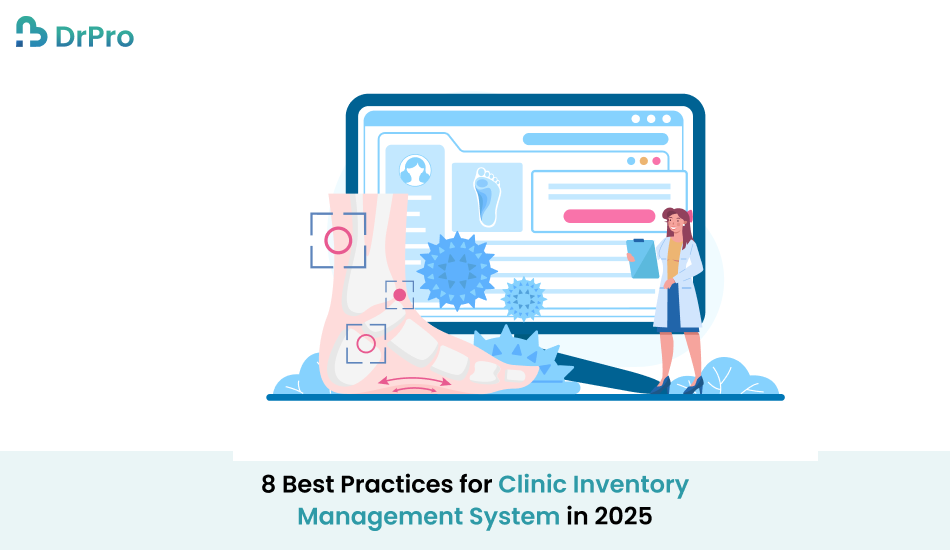This paper finds that Clinic Inventory Management is crucial for clinics so that everyday operations and patient care are not interrupted. That is why an efficient inventory system helps avoid waste and stockouts and adjust unnecessary expenses. In 2025, innovation in many technologies and new techniques will help clinics in inventory management. In this paper, eight strategies explain how clinics can make their Clinic Inventory Management system more effective.
1. Understanding the Importance of Inventory Management
In the following examples, let’s discuss in detail why Clinic Inventory Management is important.
Inventory control therefore concerns the monitoring of supplies medications and equipment required in running clinic activities. Effective inventory control minimizes instances whereby stocks of some products are depleted thus resulting in interruption of patients’ care.
Inadequate inventory selecting systems increase risks of over-ordering, ordering or the stock proves obsolete, the hospital loses money and the patient’s quality of care is affected. Clinics need to ensure there is enough stock with them while at the same time not ordering too much that puts a strain on the clinics. It increases effectiveness in operations and makes certain that resources are employed optimally.
For instance, inventory is a way to help clinics control their supplies and order them back when necessary. This cuts out occurrences of emergent situations, that vital goods lack if needed at certain times.
2. Embrace Automation and AI
There are many ways through technology enhancement Clinic Inventory Management System in clinics has changed a lot. Automation helps minimize counting and updates of records of stocks and artificial intelligence provides the models for better forecasts.
Automation Benefits:
- Inventory tracking systems with fully automated means of tracking completely do away with common errors.
- Audible signals remind the employees that the stocks are low and therefore need to be restocked quickly.
AI Applications:
- These software programs involve data on past usage to predict future usage.
- At the clinic level, the results of the predictive analytics assist clinics in avoiding excess working capital inventory and stock-out situations.
AI also helps to recognize patterns, for example, daily or weekly usage of medications, and, potentially, their seasonal usage. When used effectively, this technology will help clinics make the right procurement decisions and therefore do away with wasteful expenditure.
3. Real-Time Inventory Tracking
Online tracking of inventories is important for clinics who want to achieve accurate record keeping of their stocks. This also makes the task of management much more streamlined, as clinics always know what stock is in supply, while eliminating situations where supply may be out, yet the clinic has plenty that could lead to stockouts, or conversely where supplies can pile up and block the clinic’s work if the clinic has too much stock.
While real-time tracking, technologies such as barcode scanning and RFID are common. These tools enable the clinics to record new inventory, discharge, or renewal, without manually having to do it time after time.
Benefits of Real-Time Tracking:
- Real-time coverage of inventory status.
- Incorrect data entry as a result of manually keying in numerical will be minimized.
- Reduced loss through improved control of traded stocks.
For instance, a barcode scanning system will simultaneously enhance the exacting stock control since it will alert the system as soon as a medicinal product is dispensed or taken in. This practice ensures that the inventory stays ‘real-time’ always, and does not have to be updated manually.
4. Regular Audits and Stock Reconciliation
Another common practice that has to be controlled to be accurate is inventory audits, which, in turn, should be, conducted regularly. They require a physical count of the stock on hand and then a comparison with the records on the stock. It assists in finding out the differences that exist and tying the loose ends to meet organizational goals.
Stock reconciliation deals with the physical value of the record-keeping of stock. This is why clinics should make audits mandatory, for example, at the weekly, monthly, or other periods.
Steps for Effective Audits:
- The inspection should be time-based, but more frequent inspections should be based on the frequency of stock turnover.
- Staff should be given to double-check stock levels or maybe record any differences.
- Find out reasons why they happen and reconcile records if necessary.
The same also assists clinics in identifying slow-moving or expired items within their stores so that they can make the necessary adjustments promptly.
5. Integration with Other Systems
Most clinics have other software that they use for different aspects and activities in the clinic, and integrating the Clinic Inventory Management system in 2025 within clinic software makes it easier and more efficient in its working. Clinics can benefit from linking inventory systems with EMR, billing, and appointment scheduling software and eliminate inconsistent or multiple systems.
Benefits of Integration:
- Automatic stocking when the commodity has been used on the patient.
- Easy-to-bill systems are realized because Clinic Inventory Management forms an integral component of patient records.
- Being able to get data and information all in one place to enhance decision-making was also an advantage.
For example, if a doctor is prescribing a certain medication, the EMR system will easily subtract the same from the stock. It also prevents manual synchronization, thereby providing accurate tracking for integrated records.
6. Vendor Management and Procurement Planning
The supply management chains depend on friendly and dependable suppliers to avoid disruptions in supplies. Clinics should engage appropriate vendors negotiate better deals and guarantee that their deliveries are on time.
Vendor Management Strategies:
- It is important to also have a list of preferred vendors for major supplies these should be ongoing.
- This will involve daily communication concerning the number of stocks you need and how soon you need them.
- Keep track of the performance of the vendors to avoid failure and unsatisfactory quality delivery.
Procurement planning is equally essential. Officials in clinics should study patterns of use so that they can identify proper reordering points for many different supplies. They say that clinics should order supplies in advance to avoid mid-conversation or mid-process shortages and that this approach also results in better prices for the clinics from the vendors.
7. Data-Driven Decision-Making
This paper explains that data analytics is critical in managing inventory since it offers insights into the usage of such products over time. Using the inventory information, clinics can make the right decision as far as stocking and procurement are concerned.
Key Metrics to Monitor:
- Stock turnover rates to determine fast-moving stocks.
- The rates at which stationary should expire to avoid excessive wastage.
- Frequency of order to enhance the procurement time schedules
For instance, if analysis establishes that a specific drug is rarely prescribed clinics can order small quantities rather than many. In the same way, the determination of high-traffic use times enables clinics to prepare in anticipation for hhigh-trafficstates.
8. Focus on Sustainability and Compliance
There is often sustainability in managing inventories or practices that make little or no waste of resources in inventory. Measures that clinics can take include recycling facilities for javelin sticks and packing such that they reduce packing material that is likely to end up as waste.
The other general purpose is regulation compliance which is a crucial aspect of any business. Clinics need to abide by principles concerning the archiving of appliances and consumables. This includes ensuring a certain temperature is preserved when storing some medications, and correctly disposing of some products that have outlived their shelf life.
Steps for Compliance:
- All inventory practices have to be done in compliance with the country’s laws.
- I have prepared the employees specifically on how to store and dispose of the waste in the right manner.
- Have record keeping of the movements of inventories for auditing purposes.
This paper also emphasized that clinics to pay attention to both sustainability and compliance as a way of minimizing harm to the environment as well as protecting patients.
Technological Advancements in Inventory Management

The interviewees pointed out that technology is the major determinant of inventory management practices in 2025. The following innovations are making a significant impact:
IoT Devices:
IoT sensors would track stock or other items using appropriate storage conditions and the environment.
Cloud-Based Systems:
The cloud solutions give clinics a centralized database for inventory information for working on stock control.
Mobile Apps:
Mobile applications allow the staff to input the records and check stock details from the inventory applications.
By implementing the said technologies not only do they improve efficiency but clinics are equipped with what they need to be competitive.
Clinic Inventory Management is one of the most sensitive and also difficult areas within the production and manufacturing field.
Challenges in Inventory Management

Stockouts:
Stocking shortages affect patient care in that there will be limited stock to manage patients’ needs.
Overstocking:
Being an inventory, the excess stock can hold up resources and lead to wastage.
Expired Products:
Some of the material is unused and may even get out of date before they are put into use.
Lack of Integration:
There is always a problem with disjointed systems as this creates delays and leads to errors.
To address such challenges mechanisms have to be put in place such as annual audits, data analysis, and incorporation of advanced technologies.
Conclusion
Effective Clinic Inventory Management is a cornerstone of successful clinic operations. By adopting practices like automation, real-time tracking, and data-driven decision-making, clinics can optimize their inventory processes in 2025. Focusing on sustainability and compliance further enhances efficiency and ensures long-term success.
By implementing these strategies, clinics can improve patient care, reduce costs, and streamline operations, setting a strong foundation for growth.
FAQs
Q1. How can clinics implement real-time Clinic Inventory Management tracking?
Clinic Inventory Management can use barcode scanning or RFID technology to update inventory records instantly.
Q2. What is the role of automation in Clinic Inventory Management?
Clinic Inventory Management Automation simplifies tasks like stock tracking and reordering, reducing manual errors.
Q3. Why is integration important in Clinic Inventory Management?
The integration connects Clinic Inventory Management with EMR and billing software, improving workflows.
Q4. How can data analytics help with Clinic Inventory Management?
Clinic Inventory Management Analytics provides insights into usage patterns, enabling clinics to optimize stock levels.
Q5. What are some sustainable Clinic Inventory Management practices?
Recycling unused items, minimizing waste, and adhering to disposal guidelines are key practices.


